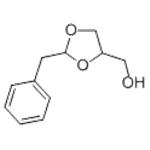Chemical Properties
Phenylacetaldehyde glyceryl acetal has a faint, sweet, rosy odor and a sweet green flavor.
Chemical Properties
2-Benzyl-1,3-dioxolan-4-methanol is not found in nature. It is a colorless, slightly viscous liquid,
d
204 1.154–1.162, n
20D 1.529–1.534, with a tenacious honey, cyclamen, and rose
note. It is prepared by acetalization of phenylacetaldehyde with glycerine.
Occurrence
Has apparently not been reported to occur in nature.
Uses
2-Benzyl-5-hydroxymethyl-1,3-dioxolane has very pleasant effects when
used in sufficiently high concentration in
Rose, Chypre, Hyacinth, Lilac, etc. as an
“undertone” material. It is excellent for
“forest “-green undertones in Muguet, or for
the deep-green leafy notes of Lilac, but it
needs supporting notes, and it is not a powerful odorant. It is also used in flavor
compositions as a fixative in certain fruit types,
and in “floral” flavor types as a bouquetting
material in traces. The concentration used is
about 5 to 20 ppm in the finished product.
Definition
ChEBI: 2-Benzyl-5-hydroxymethyl-1,3-dioxolane is a member of benzenes.
Preparation
From phenylacetaldehyde and glycerol.
Toxicity evaluation
The acute oral LD
50 value in rats was reported as 1.72 ml/kg (1.57-1.87 ml/kg) and the acute dermal LD
50 value in rabbits exceeded 2 g/kg (Moreno, 1972). The ip LD
50 for mice was found to be 2.7 ± 0.23 mmol/kg (523.8 ± 44.62 mg/kg) and the mean paralysing dose (ED50) for ip administration to mice was found to be 0.77 + 0.07 mmol/kg (Berger, 1951).
Flammability and Explosibility
Non flammable
Trade name
Acetal CD (Givaudan).
Metabolism
Acetals hydrolyse readily in the presence of acids to generate the corresponding aldehydes and alcohols (Fassett, 1963).


